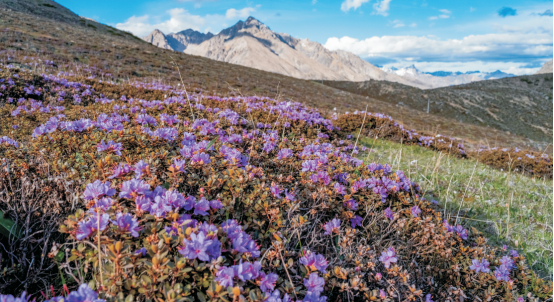In my spare time, I broke two branches of the flowers and held them in my hands, observing them.
They are too beautiful to be earthly things. It is the beauty Ms XI Shi of the flowers; compared with it, both lotus and peony are ugly.

雪层杜鹃 Rhododendron nivale
In March of 816, the great poet BAI Juyi, who lived in Jiangzhou (now Jiujiang City) at the time, wrote a poem called The Mount Pomegranate to YUAN Jiu. his close friend YUAN Zhen. He praised the Mount pomegranate (in Chinese Shan-shi-liu) as the most beautiful flower in the world, like the legendary beauty XI Shi. He must have been fond of this tender purple and red flower; otherwise, he would not have transplanted it at his garden to observe and describe it in detail. The Mount pomegranate, referred to by the Tang people, is probably the species we now call Rhododendron simsii, which is very common in the southern mountains of China and has an intuitive and widespread name, Ying-shan-hong (means coloring the mountains red). The metaphor of R. simsii is conveyed concisely, but the poet may have been careless. What if there were more than one XI Shi?
Today, what we commonly call rhododendron (in Chinese, Du-juan flower) refers to plants of the genus Rhododendron in the family Ericaceae. Rhododendron is a large group of about 1000 wild species widely distributed in Europe, Asia, and North America, even reaching the Arctic and Oceania. It is the largest genus of woody plants in the Northern Hemisphere. Rhododendron species are primarily evergreen (deciduous rhododendrons, also known as azaleas), are plants that are mainly shrubs but also tall trees, tiny prostrate plants, and even epiphytes. East and Southeast Asia are the distribution centers of the genus, and China is a sanctuary for these plants - about 570 species of wild Rhododendron grow in China, accounting for about 60% of the world’s diversity. Most strikingly, more than 400 of these species are endemic to China. Wild Rhododendron species can be found in most of the provinces and regions of China. If the great poet BAI Juyi had been a diligent hiker, he would have seen at least five species of Rhododendron, including R. simsii, R. fortunei, R. farrerae, R. ovatum,and R. molle, in the city of Jiangzhou and Mount Lushan where he lived at the time. They have different temperaments and appearances but also have the same fantastic beauty. Ask who among them cannot be the beauty, Ms XI Shi?

绵毛杜鹃 Rhododendron floccigerum
The ancients did not know today’s plant taxonomy, but they visually discovered the connection of common Rhododendron species through long observation and comparison. In his poem, BAI Juyi wrote that the Mount pomegranate, also known as Shan-zhi-zhu, is also called Du-juan flower. The name Mount pomegranate, first seen in the Eastern Jin Dynasty (317-420), reveals people’s earliest observation of this wildflower - born in the mountains, with a color similar to that of pomegranate, gorgeous as fire. The name Shan-zhi-zhu probably comes from the Yang-zhi-zhu (R. molle), which is widely distributed and has yellow flowers and was the first recorded Rhododendron species in ancient Chinese books. Later, it was discovered that, despite the different colors, the flowers and leaves of the Yang-zhi-zhu are fairly similar to those of the Mount pomegranate, and slowly the Mount pomegranate was also called Shan-zhi-zhu. And where did the name Du-juan come from, that we still use today? It probably came from the cuckoo bird (in Chinese Du-juan). The Tang people heard the cuckoo birds sing when the Mount pomegranate bloomed, so the two names were linked.

大白杜鹃 Rhododendron decorum

鲜黄杜鹃 Rhododendron xanthostephanum
Who doesn’t love this flowering, richly colored-beauty? The Tang people began to collect wild rhododendrons and plant them in their gardens and even at court as a symbol of passion and wealth; the literati of Jiangzhe regions (now Prov. Jiangsu and Prov. Zhejiang) in the Song Dynasty, loved to move them into their private gardens, and there was a custom for women to put rhododendron flowers in their hair buns. In the Ming and Qing dynasties, people learned more about the habits of rhododendrons and grew them in potted plants to decorate their homes, which is recorded in the book Treatise on Superfluous Things by WEN Zhenheng, a famous scholar in late Ming Dynasty (1368-1644). Unfortunately, the number of standard and suitable cultivated species of rhododendrons was relatively limited for the wealthy literati living in the urban areas of central China and the middle and lower reaches of the Yangtze River. The provinces with the most incredible diversity of Rhododendrons in China are Yunnan, Xizang, and Sichuan. The geological and climatic evolution of the Himalayas and the Hengduan Mountains opened up infinite possibilities for biological evolution. Here 75% of the country’s Rhododendron species are found, growing resiliently in the mountains, full of hardships and dangers for humans. In 1639, the famous traveler XU Xiake recorded in his Diary of a Journey to Yunnan (VIII-X) the splendor of the rhododendrons he saw in villages and temples along his travels through Yunnan. He also participated in the planting of rhododendrons with local people. XU Xiake, born and raised in Jiangyin (a city now in Jiangsu Province), may have also viewed rhododendrons in his hometown’s gardens and potted plants too. What he admired in Yunnan were, I’m afraid, very different species that were rarely seen by the people living in central and eastern China at that time.
In 1629, on the other side of the world, a Frenchman first used the name “rhododendron” to describe these plants in his book and recommended them to the world as horticultural species. The name is derived from the Greek words rhodon, meaning rose (color), and dendron meaning tree, which combine to form a small tree with flowers similar in color to the rose. The name visually reflects the Europeans’ impression of the common rhododendrons at that time and is similar to our Mount pomegranate. In 1753, the Swedish botanist Linnaeus established the genus Rhododendron in his book Species Plantarum, and thus people began to explore new ways of understanding these beautiful flowers and their relationships. His book described ten species of Rhododendron (some of which were placed in the genus Azalea), and the genus was still a small group at that time.

毛喉杜鹃 Rhododendron cephalanthum
In the early 19th century, the first Rhododendron from China, Yang-zhi-zhu (R. molle), arrived in Europe. In the decades that followed, collectors such as Robert Fortune, Pere Armand David, Augustine Henry, Ernest Henry Wilson, George Forrest, Frank Kingdon-Ward, and others, collected large numbers of Rhododendron specimens, seeds, and live plants from China and brought them back to botanical gardens, museums, and other institutions in Europe and the United States. The Chinese rhododendrons sparked a great frenzy for over a hundred years that influenced and changed the world’s gardens. Through the long-term efforts of horticulturalists, new varieties are constantly cultivated. Today, there are over 30,000 hybrids of Rhododendron worldwide.
Living in modern times, we have many opportunities to encounter rhododendrons. A botanist called them the longest landscape in China. Every year, from March to July, whether in city parks, the countryside, mountains, snowy plateau, or, of course, in this flower show, we can see wild Rhododendron species and their horticultural offspring blooming one after another. From south to north and east to west in China, red like flame, pink like clouds, yellow like stars, and white like jade, creating the most passionate and intense spring on the branches for a long time.

三花杜鹃 Rhododendron triflorum

鳞腺杜鹃 Rhododendron lepidotum
The Yi people (one of the ethnic groups in China), who live in the mountains of southwest China, have loved rhododendrons for generations. They hold a ceremony each spring to worship the god of rhododendrons. If the plants bloom profusely that year, they are expected to have a good harvest. In the spring, they raise their eyes to the blooming clusters of Rhododendron flowers and make a wish for abundance and prosperity. The joy and beauty of flowers, past and present, have not only captivated poets but have also brightened the lives of all of us.





